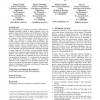ITICSE
2004
ACM
14 years 5 months ago
2004
ACM
This paper explores some of the issues associated with teaching computer science to students with dyslexia. Issues associated with both student learning generally and computer sci...
ITICSE
2004
ACM
14 years 5 months ago
2004
ACM
User Mode Linux is a virtual machine running on a GNULinux operating system. It is the right choice for teaching operating systems’ administration, as it does not need any dedic...
ITICSE
2004
ACM
14 years 5 months ago
2004
ACM
Peer assessment is a technique that has been successfully employed in a variety of academic disciplines, and which is considered to be effective in developing student’s higher c...
ITICSE
2004
ACM
14 years 5 months ago
2004
ACM
Keeping students alert and responsive during lectures is a challenge even for experienced teachers in small group settings. Research has shown the importance of student participat...
ITICSE
2004
ACM
14 years 5 months ago
2004
ACM
SQL (Structured Query Language) is one of the essential topics in foundation databases courses in higher education. Due to its apparent simple syntax, learning to use the full pow...
ITICSE
2004
ACM
14 years 5 months ago
2004
ACM
With our interest to improve our education in computer science, an understanding of how students learn about CS concepts, how different concepts are understood, as well as the con...
ITICSE
2004
ACM
14 years 5 months ago
2004
ACM
This paper describes a knowledge unit and the use of a software tool, DesignMentor, for teaching a very challenging topic in computer graphics and visualization, namely: curve and...
ITICSE
2004
ACM
14 years 5 months ago
2004
ACM
Prior research on pair programming has found that compared to students who work alone, students who pair have shown increased confidence in their work, greater success in CS1, an...
ITICSE
2004
ACM
14 years 5 months ago
2004
ACM
This paper examines the effect of grading approaches for SQL query formulation on students’ learning strategies. The way that students are graded in a subject has a significant ...
ITICSE
2004
ACM
14 years 5 months ago
2004
ACM
Final year, group (capstone) projects in computing disciplines are often expected to fill multiple roles: in addition to allowing students to learn important domain-specific knowl...




